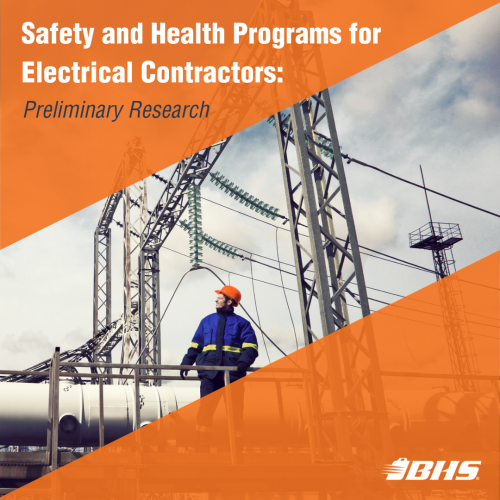We use cookies to make your experience better. To comply with the new e-Privacy directive, we need to ask for your consent to set the cookies. Learn more.
Safety and Health Programs for Electrical Contractors: Preliminary Research

Even the codes and regulations that we think of as the cornerstone of safe electrical work aren’t sufficient on their own to reduce injury rates. To put these safety standards to work, employers need to build strong, easy-to-follow safety programs. Research is a crucial first step in designing these protocols.
We’re assuming employers in the electrical industry already understand the three core parts of a workplace safety program (if not, read our coverage of the topic here [https://na.bhs1.com/three-parts-of-an-effective-workplace-safety-program-according-to-osha/].) How can electrical contractors ensure that their safety programs are working on a day-to-day basis? Here are a few places to start on background research for truly effective safety protocols in the electrical industry:
- Understand the Most Common OSHA CitationsThe Occupational Safety and Health Administration provides valuable data on hazards in other, similar workplaces. There’s no reason to join them in their citations when you can learn from their mistakes and prevent injuries before they happen.
Between 2011 and 2018, for instance, the top OSHA citations among electrical contractors were: 1926.453(b) — Fall protection during aerial lift use; 1926.501(b)(1) — Fall protection from walking/working surface with an unprotected edge of six feet or more; 1926.416(a)(1) — Protection against electric shock from electric power circuit; and 1926.405(b)(1) — Protection of conductors entering boxes, cabinets, or fittings from abrasion.
When you know what your peers are missing, you can make sure to address these items in your safety plan.
- Study the Leading Causes of Injury Among Electrical ContractorsThe U.S. Bureau of Labor Statistics tracks injury events by NAICS value. According to the latest year, 2017, for NAICS 23821, Electrical and Wiring Contractors, the top causes of injury were, from most-common to less-so: Overexertion and bodily reaction; falls, slips, and trips; contact with an object or equipment; falls onto the same level; and being struck by an object.
- Review the Relevant Standards and RegulationsMany electrical contractors work within the construction field. For these employers, the standards found in Part 1926 of the OSHA regulations are crucial for preventing injuries. Pay particularly close attention to Standard Number 1926.416, which covers working near electrical equipment.
For contractors outside of the construction industry, OSHA Part 1910 is full of safety standards that can make a difference. Be sure to check Standard Number 1910.137 to learn about personal protective equipment in electrical applications.
No safety program for electricians is complete without NFPA 70E, Standard for Electrical Safety in the Workplace. These resources act as important guides when designing any electrical safety program.
Why all this emphasis on codes and regulations? A formalized safety program, complete with written documentation, is likely to be more effective than less rigorous standards. In order to get the program right, though, research is required. The resources and facts listed above can help electrical contractors get started on analysis of safety issues at job sites.
To take the next step, see OSHA’s best practices guide to establishing a workplace safety and health program, available here. Or contact Independent Electrical Contractors (IEC) for copies of their Jobsite Safety Handbook and Safety Manual Guidelines.
References:
“Electrical Contractors Hazard Information.” OSHA. U.S. Occupational Safety and Health Administration, 2018. PDF. 18 Jul. 2019.
“Occupational Injuries/Illnesses and Fatal Injuries Profiles.” BLS. U.S. Bureau of Labor Statistics, n.d. Web. 18 Jul. 2019.
